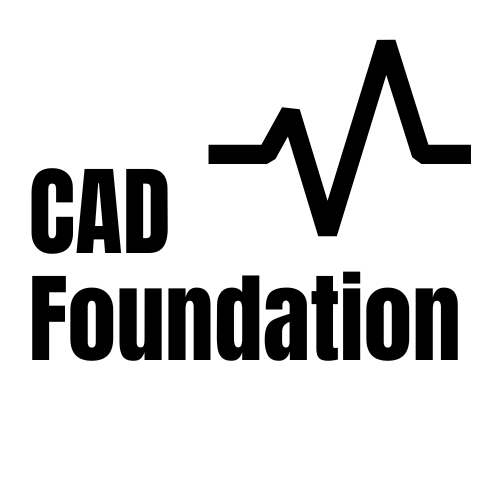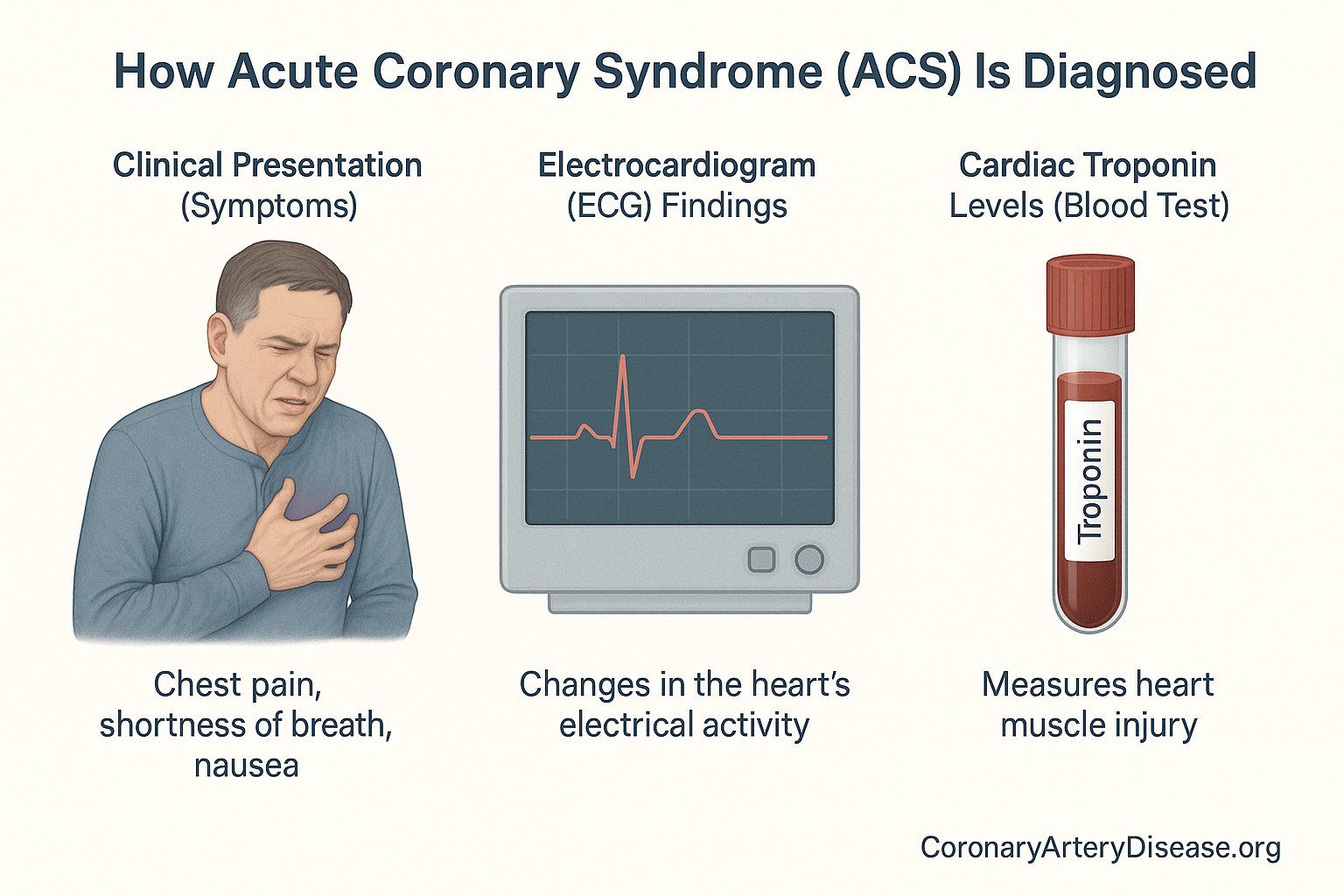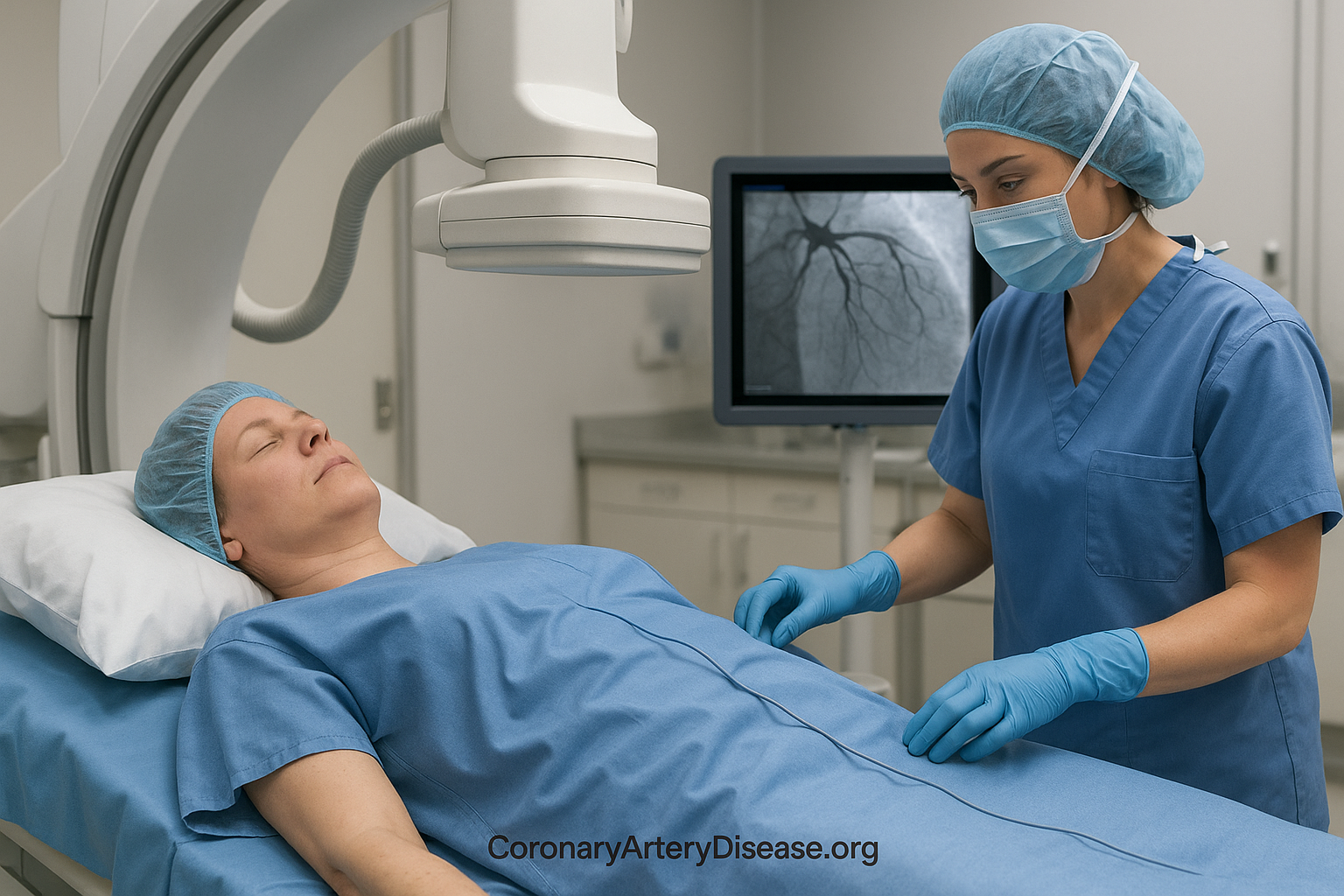When diagnosing Acute Coronary Syndrome (ACS), medical professionals rely on a combination of factors to understand what is happening with a patient’s heart. It’s a critical process because timely and accurate diagnosis leads to the best possible treatment.
Overview
Acute Coronary Syndrome (ACS) is a term used to describe a range of serious heart conditions where there is a sudden reduction in blood flow to the heart muscle, leading to myocardial ischemia (lack of oxygen to the heart muscle). This can manifest as unstable angina (chest pain due to reduced blood flow, but no heart muscle damage) or a heart attack (myocardial infarction or MI), which involves actual damage or death of heart muscle cells.
The diagnosis of Acute Coronary Syndrome primarily involves a careful look at three key areas: a patient’s symptoms, the results of an electrocardiogram (ECG), and specific blood tests that measure markers of heart muscle damage, known as cardiac troponins. These elements help doctors determine the type of Acute Coronary Syndrome and the best course of action.
In Detail : The Diagnosis of Acute Coronary Syndrome
First, here’s a quick list of the main components used to diagnose ACS:
•Clinical Presentation (Symptoms)
•Electrocardiogram (ECG) Findings
•Cardiac Troponin Levels (Blood Tests)
Second, let’s explore these in more detail:
1. Clinical Presentation (Symptoms):
When a patient might be experiencing Acute Coronary Syndrome, doctors first consider their symptoms. The most common symptom is chest pain, but this can also appear as discomfort in other areas like the upper arm, jaw, or upper stomach. Other common symptoms include shortness of breath (dyspnea), sweating (diaphoresis), nausea, unusual fatigue, or fainting (syncope). It’s important to know that these symptoms can occur with physical effort or even at rest, and the pain is often spread out rather than in one specific spot. It is also important to note that women, older patients, and those with diabetes may experience atypical symptoms like palpitations (a feeling of a racing or pounding heart), or even present without any symptoms at all. A thorough review of a patient’s past medical history, including any prior heart conditions or risk factors, is also crucial.
2. Electrocardiogram (ECG) Findings:
An ECG is a simple and quick test that records the electrical activity of the heart. Doctors look for specific changes in the ECG pattern that can indicate if the heart muscle is experiencing a lack of blood flow. The most significant finding is ST-segment elevation, which is a classic sign of a severe type of heart attack called ST-elevation myocardial infarction (STEMI). If there are no persistent ST-segment elevations, but other signs point to Acute Coronary Syndrome, it’s generally classified as non-ST-segment elevation acute coronary syndrome. It’s crucial to remember that ECG changes alone might not always be enough for a definitive diagnosis, as other conditions can sometimes cause similar ECG abnormalities.
3. Cardiac Troponin Levels:
These are specific blood tests that measure proteins released into the bloodstream when heart muscle cells are damaged. Cardiac troponin (specifically troponin I or T) is the preferred marker because it is highly sensitive and specific to heart muscle injury. A diagnosis of a heart attack (MI) requires evidence of this heart muscle damage, typically shown by a rise and/or fall in troponin levels. Doctors measure troponin levels when symptoms first appear and again a few hours later (e.g., 1-3 hours later) to see if the levels are increasing, which helps confirm ongoing heart damage. High-sensitivity troponin (hsTn) assays are advanced tests that can detect very small amounts of troponin earlier, allowing for quicker “rule-out” or “rule-in” of a heart attack. However, it’s important to note that elevated troponin can also be caused by other medical conditions not related to Acute Coronary Syndrome, such as heart failure or kidney disease, so it’s not used in isolation for diagnosis.
Other Similar Questions
What is Acute Coronary Syndrome?
Acute Coronary Syndrome is a broad term for conditions where there’s a sudden, severe reduction in blood flow to the heart, which can lead to a heart attack or unstable chest pain
What are the main types of Acute Coronary Syndrome?
The main types are unstable angina (chest pain without heart damage), non-ST-elevation myocardial infarction (NSTEMI) (a heart attack without specific ECG changes), and ST-elevation myocardial infarction (STEMI) (a severe heart attack with distinct ECG changes)
Why is early diagnosis important?
Early diagnosis is absolutely vital because it allows for prompt treatment to restore blood flow to the heart, which can prevent further damage, save heart muscle, and ultimately improve outcomes and prevent potentially fatal consequences
Can other conditions cause similar symptoms?
Yes, conditions like inflammation around the heart (pericarditis), a tear in the main artery (dissecting aortic aneurysm), lung problems like a pulmonary embolism, or even anxiety can cause symptoms similar to Acute Coronary Syndrome
Resources
- Bergmark BA, Mathenge N, Merlini PA, Lawrence-Wright MB, Giugliano RP. Acute coronary syndromes. Lancet. 2022 Apr 2;399(10332):1347-1358. doi: 10.1016/S0140-6736(21)02391-6. PMID: 35367005; PMCID: PMC8970581.
- Smith JN, Negrelli JM, Manek MB, Hawes EM, Viera AJ. Diagnosis and management of acute coronary syndrome: an evidence-based update. J Am Board Fam Med. 2015 Mar-Apr;28(2):283-93. doi: 10.3122/jabfm.2015.02.140189. PMID: 25748771.


